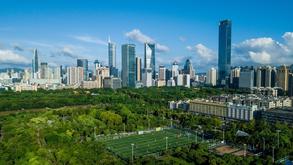 This aerial photo taken on Aug 13, 2020 shows a view of Shenzhen, South China's Guangdong province. (PHOTO / XINHUA)
This aerial photo taken on Aug 13, 2020 shows a view of Shenzhen, South China's Guangdong province. (PHOTO / XINHUA)
Shenzhen completed its first carbon trading by individuals on Dec 12, marking a milestone in the city’s push to establish a carbon inclusive system in which smaller businesses and the public can benefit by reducing carbon emissions.
According to Shenzhen's methodology, each person can save 26.9 grams of carbon dioxide emissions per kilometer by taking pure electric buses, and 46.8 grams by taking the metro.
The move is part of Shenzhen’s broader efforts to promote green development by contributing to the nation’s “dual carbon” goals of peaking carbon dioxide emissions by 2030 and achieving carbon neutrality by 2060.
ALSO READ: Can voluntary carbon market be established in SAR?
The amount of emission reductions made by a Shenzhen resident through green travel was listed and traded on the China Emissions Exchange. The resident was offered free subway tickets as an incentive.
Reduced carbon dioxide emissions by local people are calculated through Blue Planet — a WeChat mini program jointly developed by the Shenzhen Municipal Ecology and Environment Bureau, China Emissions Exchange and Tencent — when they take public transportation using the Tencent ride code.
ALSO READ: EU agrees law to make airlines pay more for carbon emissions
According to the city’s methodology, each person can save 26.9 grams of carbon dioxide emissions per kilometer by taking pure electric buses, and 46.8 grams by taking the metro.
Users of the online platform can also earn carbon credits in their personal carbon accounts and given incentives for green travel. The highest carbon credit of Shenzhen residents currently stands at 8,317 scores — equivalent to having cut carbon dioxide emissions by a ton.
ALSO READ: Low carbon, digitalization to boost industry transition
Shenzhen unveiled a work plan in November last year to build a carbon inclusive system, which aims to promote low-carbon production among small and micro-sized enterprises, as well as a green lifestyle among individuals, by valuing their carbon reduction habits and giving incentives.


